- Time
- (Edited)
- Post link
A note about images: These are not 100% faithful to the clarity and sharpness of the actual product, however they represent a decent point of illustration.
So, a well connected friend of mine passed along something to me a few days ago. It was an unlabeled dual-layered DVD. He said it was the best home video release of Star Wars ever done. He said it was done by a professional editor, who restored the film himself from the LD using professional-grade tools. He said only five or six people have a copy of this right now, but that the editor said it is good to disseminate and that it would be appearing on the web sometime soon.
I wasn’t sure what to expect, but when I watched the thing—he was damn right. I’ll admit it: the GOUT was better than any Laserdisc preservation, even Moth3r and the Editdroid/Mysterious Mysteries editions. Maybe the X/0 project could surpass it, but mainly because it is using some Black Magic effects so it’s not a strict LD preservation (and that project’s dead anyway), and G-Force’s scripting obviously is cleaner, but it isn’t without it’s own problems. This thing blows away the GOUT, and it blows away every previous pure capture. I wasn’t sure who did this or where it came from, (the title on the menu simply says 1977 Theatrical Version) but a note at the end of the technical description had aurebesh writing. I looked up the aurebesh dictionary and translated it as:
“—Editdroid”
Editdroid has taken a completely new pass at the film.

The menu is stunning, first off, opening with a full-motion montage of posters with music and sound effects, celebrating the original release. Professional grade, a very spiffy intro. So how does the film look and sound? Well, this is a dual-layered DVD, first off, which should tell you the high quality to expect. All the layers are used for the film, except for a technical explanation in onscreen text detailing the process Editdroid used this time around. I’ll let him speak for himself:
"Picture
The DVD video was created using the 1993 non-anamorphic LaserDisc version upscaled to 720p to extract a 16:9 standard definition element. Great pains were taken to retain the look of the 1993 telecine, rather than trying to match the 2004 version. Outside of transferring an original 35mm print, this is the best available source of the 1977 version of Star Wars.
To achieve this, the 4:3 master was rendered out frame by frame and into Photoshop where it was cropped to 16:9 and blown up to 720p. From there, the contrast of the low spatial frequencies (i.e., fine detail) was increased by 75% to pull out existing detail and amplify the apparent sharpness of the image. To match the look of the 1993 master, shadows and highlights were lightly compressed, and mid-range contrast expanded. The white and black points were retained, to avoid cutting off any detail. The saturation was slightly decreased, and the resulting 120,000+ images were rendered out to create a Quicktime file, then the 7.2mbps DVD master.
Sound (5.1)
A new Dolby Digital 5.1 mix was created using Ben Burtt and Gary Summers’ 1993 remaster/mix as the inspiration. A six track capture of the 2004 Special Edition 5.1 and the two track decoded into four (LCRS) of the 1993 LaserDisc Dolby Stereo mix were done in Pro Tools at 16 bit 48kHz. The 2004 DVD mix was conformed to the 1977 length, and when there were picture/audio changes, the 1993 mix was used.
No pans or fades were changed from the original mixes, and EQ was used sparingly, only when absolutely necessary to smooth a transition from the 1993 to the 2004 mix. A new Dolby Digital AC3 file was created using the maximum 448kbps settings.
Sound (Mono)
The mono mix has many differences to the stereo and the 70mm mix, including alternate takes on some lines, and Shelagh Fraser’s readings for Aunt Beru, which were replaced by a different actress in subsequent mixes. The 1977 mono mix has never been released.
The main source for the 1977 mono theatrical mix came from “The Mono Mix Restoration Project” and would not have been possible here without their hard work. The track, while mostly complete, contained audio drop outs and some gaps, which were filled from a second mono source. All audio was cleaned up to minimize the optical track crackle and rumble. The original transfer was not speed locked, so varispeed and numerous edits were required to patch and slide audio back into sync."
Sound good? It also has the original crawl, taken from the GOUT.
Here is my review of what I like to call EditDroid2 (ED2–what else should we call it?). The main question is: is the picture better than the GOUT? The answer is yes, but no in some ways. In most shots, sharpness is equal, in some shots sharpness is even better, and in some shots I would say the GOUT is a smidge sharper. The difference is splitting hairs, really. I’ll post some comparisons.
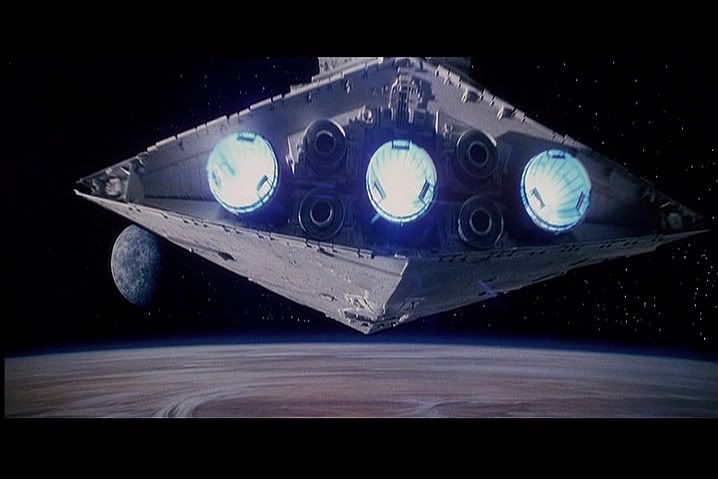
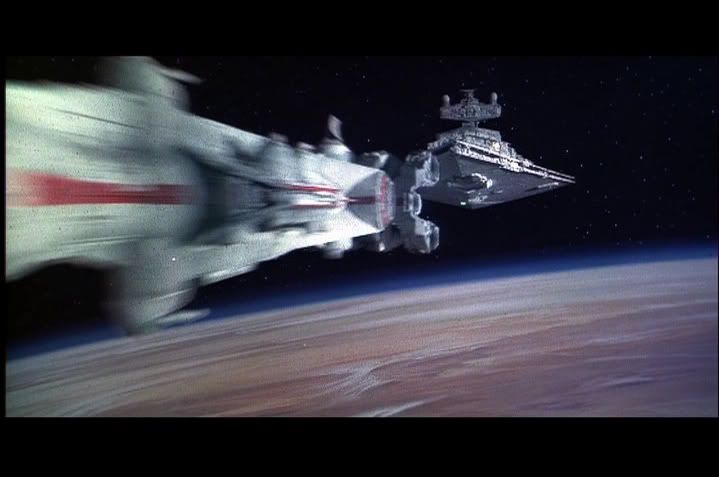
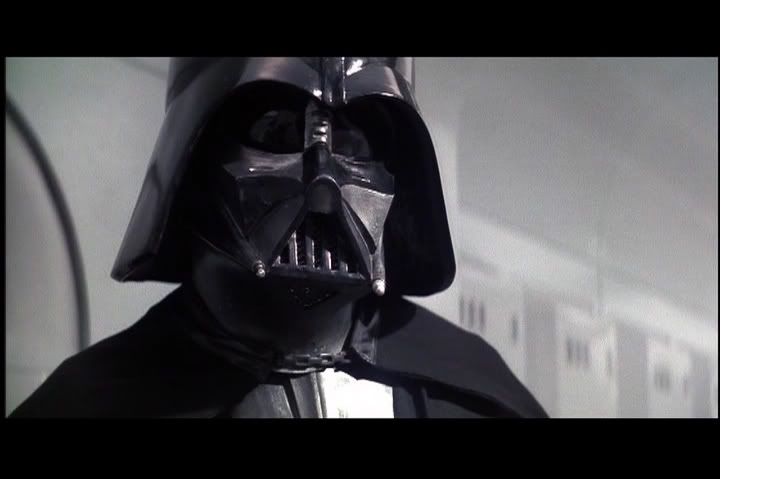
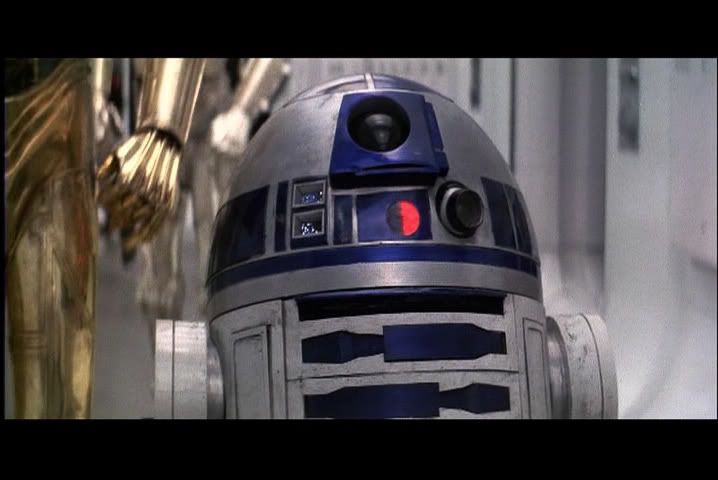
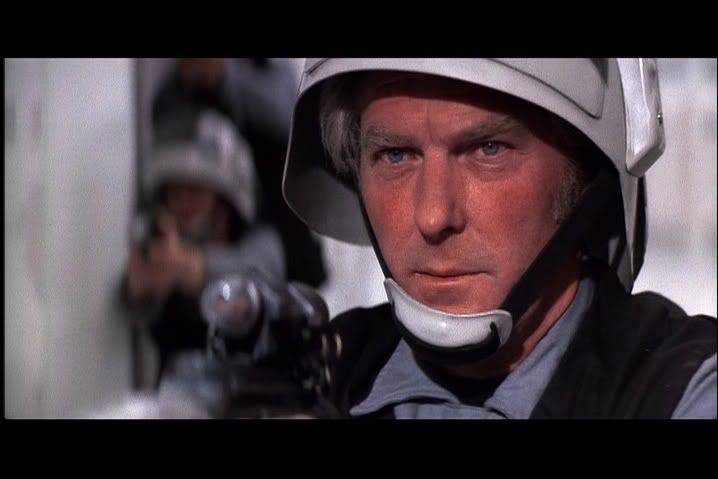
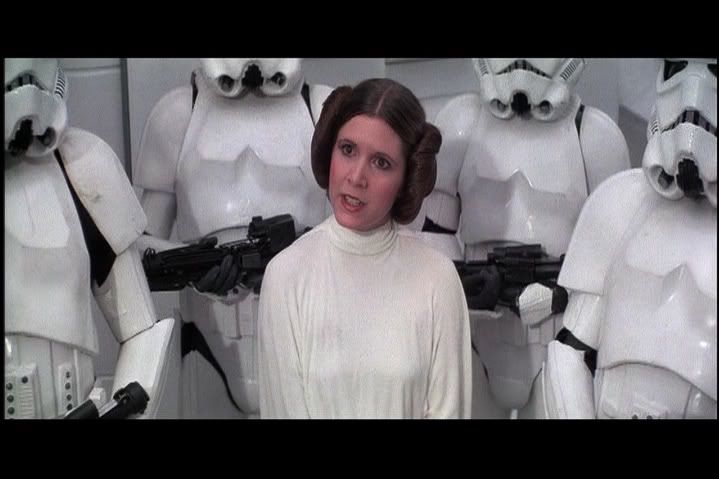
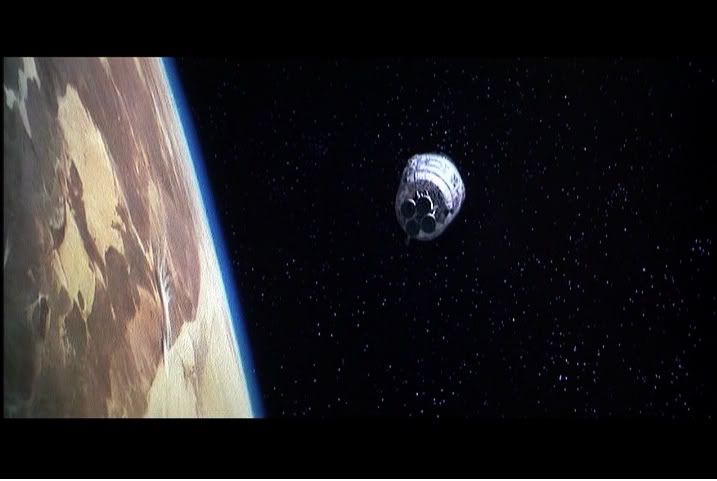

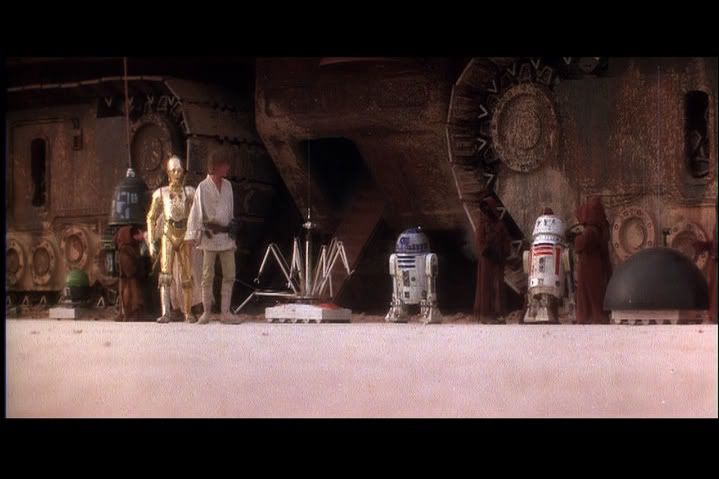
One thing to look for is that this transfer is so detailed that you can see the grain—much like on the GOUT. This shows how sharp both of these transfers were—previous versions, while good, did not get detail so fine that the grain became apparent. Maybe this is due to the sharpening processing done in Photoshop. This transfer is slightly less grainy than the GOUT. While this may indicate that it would be slightly less sharp, such is not the case overall—it seems there is a bit of a threshold where actual picture detail does not increase, but spots and grain in the transfer become more noticeable, which this release avoids for the most part. But believe me, this is grainy, and that’s a good thing because that’s how the print is, and somehow it looks more suitable here than the GOUT, perhaps because it’s not quite so heavy and coarse, it seems more like an organic part of the emulsion rather than a mask of dirt overtop of it, and I like being able to have enough detail to see the faults of the emulsion like the density changing. So, in terms of pure detail, I would say GOUT and ED2 are on about equal ground, but ED2 has better grain issues. Some people may say GOUT is a hair sharper, some people may say ED2 is about a hair sharper. It changes from scene to scene in my opinion. But overall, this transfer just looks better than the GOUT and I’m not even sure what to attribute this to since the detail level is about equal—but it’s an improvement nonetheless if you ask me. Maybe it’s simply because it has been upscaled to 720p.
Other picture issues, however: the GOUT has better detail in the highlights. It is a small issue, but one I noticed. You can see this in the example of the escape pod, where the white lighting on the pod is burning out just a bit, but there are other examples (reflections, usually) where the hot spots that have a bit of detail in the 2004 and 2006 official transfers are more burned out. However, if you look at the caps, ED2 has much better shadow and mid-range detail than the GOUT (see the pic of Vader; the caps unfortunately lost a lot of the mid range info). On the other hand, because this is sourced from the LD while the GOUT came from the D1/2 master tape, there are some mild aliasing in a few shots. It’s too bad there wasn’t anti-aliasing filters applied to the shots in which this occurs, although they are only occassional. Below is an example:
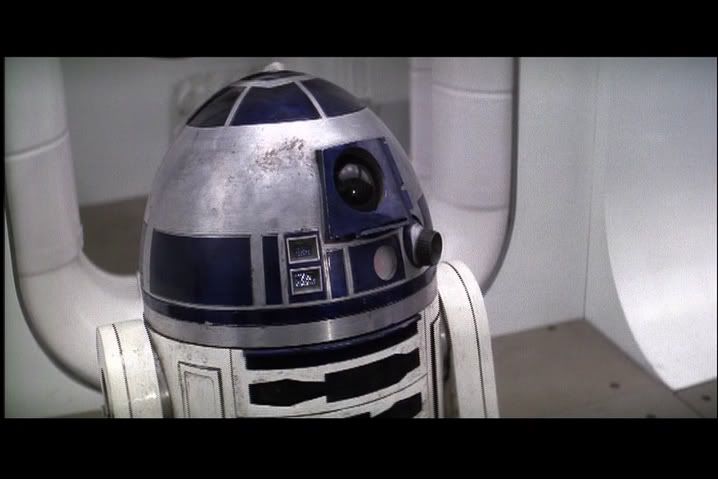
As I suspected, the GOUT seems to have had its contrast upped and its saturation nudged by just a bit. ED2 seems a bit more pink shifted in skin tones as well (similar to the 2004 master, but not nearly as bad–see the pic of the rebel trooper). None of these are necessarily “correct”, it simply depends on your preference; I prefer the GOUT skin tonality, but I also prefer the lower contrast/extra mid-range detail that ED2 gives. But, because of some occasional aliasing and highlight blows, I would say the GOUT has a mild advantage here. ED2 has some very minor edge enhancement in a couple scenes, such as the Falcon’s entry into the Death Star, whereas the GOUT does not as far as I remember. It’s extremely mild, of course, and only in a few shots, but I have to mention it.
One of the great things about this is that the subtitles have been recreated to a T and are burned in. I appreciated this touch. Sorry, GOUT, you lose here.
Also, it appears that the frame shaking that the GOUT was plagued with is gone (“gate weave” in technical terms). Select shots have a bit of weave, but in general the entire transfer seems to have been stabilized. A subtle but important improvement over the GOUT.
But of course, the big one: ED2 is anamorphic! And in 720p no less. And it looks stunning. Even on my 4x3 computer screen I noticed a great boost in picture quality. Trust me, when you pop this into your set top player and watch it on you 40” 16x9 television—you will be impressed. None of this stretching or zooming nonsense. This will be the only version of Star Wars you will ever watch until Lucasfilm restores it from a 35mm source. I’ve seen the GOUT re-transferred to anamorphic and it doesn’t look this good. The only outstanding issue is the aliasing–maybe someone here can fix that.
On to audio. The 5.1 mix is really, really good. It sounds better than the 2004 mix–it seems more lively and immersive, but maybe that’s because I haven’t listened to the 2004 mix in a few years. Ben’s original Kryatt dragon call is in there, and I believe the audio swapping and dropping from 2004 has been fixed. One thing I did notice that kind of bugged me is that in the scene where the stormtroopers are knocking on the doors in Mos Eisely the sound of the floating patrol droid is still heard in the background. Meh. Since there was no 1977 5.1 mix this is a modern bonus in some ways anyway. I really enjoyed seeing the 1977 cut in a state of the art 5.1 mix.
The mono mix is most likely the previous version on the older ED disk. It sounds amazing, and I actually prefer this to the 5.1 mix. It’s more authentic anyway. I am disappointed the stereo DE mix was not included as this would have been my preferred way to view the film. I realize Editdroid wanted to save as much room for picture as possible, but it’s too bad this couldn’t be included.
So, overall: GOUT or ED2? If you have a small 4x3 television and you already paid money for the GOUT, you aren’t going to gain a whole lot, unless you want to enjoy the mono mix. For those with larger sets and especially anyone who has a 16x9 set, no question: ED2. Until X/0 releases their project, if they ever do, this is easily the best LD transfer of Star Wars possible without going to a 35mm print or the 2004 master. Scripts like g-Force’s are impressive in their own right, but IMO they still haven’t figured out how to preserve all the detail without scrubbing out every bit of grain.
While a color corrected 2004 master would yield much better detail, the crushed blacks mean that ED2 has better detail in some ways (better even than the GOUT for shadows and mid-range). However, there is a more important reason: it will never be possible to replicate the “look” of the 1977 release via the 2004 master. This is because Star Wars was deliberately shot soft—almost every scene was soft-filtered. There is a gauzy look to the film that the 2004 master eliminated by artificial sharpening, and also by grain reduction. While Star Wars’ raw negative probably isn’t as grainy as this is, it is much closer to the original look, and because it is less grainy than the GOUT, probably is what audiences would have actually seen in a 35mm or 70mm release print. Also, editing the 2004 master to include 1977 footage usually doesn’t work out because of this difference in grain and sharpness, although Adywan was pretty successful in his (limited) attempts (which often required treating the shots as visual effect composites). For these reasons, as nice as edited and color-corrected 2004 masters are, they still aren’t as good as this. THIS is what the original 1977 release would have looked like. Okay, so the coloring on the R2 canyon scene is debatable, the binary sunset shot might be oversaturated, and the cantina might be a bit darker. To me, these things matter less, and there is still ongoing debate about most of these “changes” anyway. For me, I’d rather see the shots a bit softer, see Luke ignite his lightsaber, have a noticeable jumpcut and see the grain level double, because that’s what the film would have looked like.
In short, this is currently the best release of the original Star Wars on home video so far. It is as sharp as the GOUT, has less grain, has image stabilization, has the original crawl, has a 5.1 mix and the original mono, and is anamorphically enhanced in 720p. I suspect that it will not be surpassed until either X/0 is resurrected, the GOUT scripts get improved, or we have new material to work with—which would mean newly transferred material from a print. Until that happens, I just thought everyone should know that after Lucasfilm outdid the LD preservations with the GOUT, Lucasfilm’s GOUT has now been outdone by a LD preservation. Fuck you, Lucasfilm!
EDIT
See post #67 for a breakdown of what this transfer actually is derived from…
(hint: it’s not a Laserdisc proper)